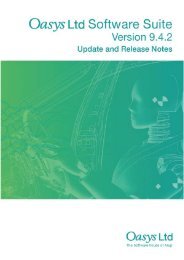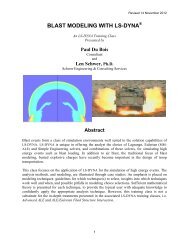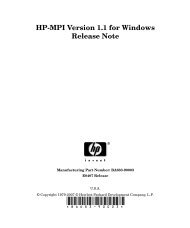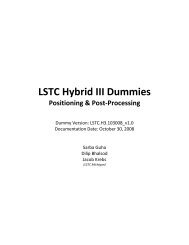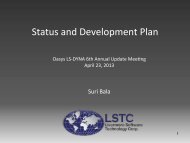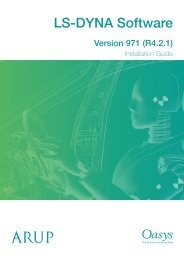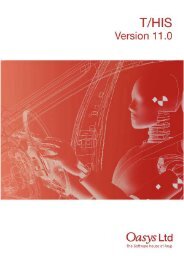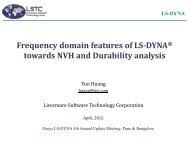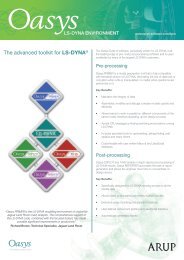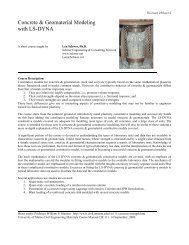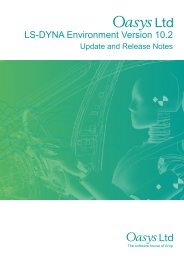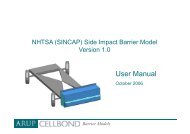Oasys LS-DYNA Environment 8.1 VOLUME 3 ... - Oasys Software
Oasys LS-DYNA Environment 8.1 VOLUME 3 ... - Oasys Software
Oasys LS-DYNA Environment 8.1 VOLUME 3 ... - Oasys Software
You also want an ePaper? Increase the reach of your titles
YUMPU automatically turns print PDFs into web optimized ePapers that Google loves.
<strong>Oasys</strong> <strong>LS</strong>-<strong>DYNA</strong> <strong>Environment</strong>: User Guide (Version <strong>8.1</strong>)<br />
Associated with springback is the *DATABASE_SPRING_FORWARD option to output a nodal<br />
force file used in an iterative approach to die correction for springback.<br />
Please contact <strong>Oasys</strong> for more information on <strong>LS</strong>-NIKE3D and its use in springback calculations.<br />
(Note that <strong>LS</strong>-NIKE3D may also be considered for simulating the blank holder warp stage of the<br />
process - this is still under development at <strong>LS</strong>TC).<br />
BLANK<br />
The undeformed blank should be meshed using shell elements as use of solids would be<br />
prohibitively costly due to the large number of elements and the small timestep required. The<br />
default B-T shell is generally acceptable but the number of integration points should be increased<br />
to five or more for increased accuracy in the springback calculation. Membrane elements can<br />
be used where cpu usage is critical but care must be exercised in interpreting the results. Wellconditioned<br />
quadrilateral elements are preferred as triangles and “chevron” elements can give<br />
local changes in stiffness.<br />
Element size in the blank should be as small as reasonable for the draw phase, although larger<br />
elements can be used in the gravity and blank holder wrap. Adaptive re-meshing is very helpful<br />
especially where there are tight radii in the tooling surfaces. If an element on the blank is too<br />
large at a tight radius excess, force will be developed leading to excess constraint or even a<br />
locked condition. Adaptivity allows the mesh to be refined locally only as required in the<br />
calculation and is more efficient than using a very fine uniform mesh. It is also much easier to<br />
prepare than a structured mesh manually refined in selected areas. The option to output the final<br />
adapted mesh without displacements is a useful way to carry out sensitivity analyses. The last<br />
version of <strong>LS</strong>-<strong>DYNA</strong> can adapt the mesh prior to contact with the tooling. This “look ahead”<br />
capability gives the most efficient and reliable implementation of adaptive remeshing (see the<br />
comments below on Control Cards for more details).<br />
In order to represent the elastic-plastic deformation of the blank, the standard material models<br />
applicable to shells may be used but there are also several models provided specifically for sheet<br />
metal forming simulation. The manufacturing process for sheet metal means that the material<br />
properties are no longer isotropic. Rolling introduces anisotropy in the through-thickness<br />
direction such that the ratio of width strain to thickness strain, r, is not unity. For most steel r ><br />
1 giving improved drawability. In addition, r can vary along or across the sheet leading to<br />
definition of r 00, r 45 and r 90 to attempt to represent the anisotropy in more detail; this is normally<br />
required to capture the behaviour of aluminium alloys.<br />
Anisotropy is included in a number of models.<br />
*MAT_TRANSVERSELY_ANISOTROPIC_ELASTIC_PLASTIC is based on Hill’s 1948<br />
quadratic yield surface taking into account normal anisotropy (the ‘r’ value); this model equates<br />
to Von Mises with r = 1. (*MAT_FLD_TRANSVERSELY_ANISOTROPIC is identical but<br />
includes definition of a forming limit diagram to calculate an additional parameter used in certain<br />
post-processors; <strong>Oasys</strong> D3PLOT does not require this variable). *MAT_3-<br />
PARAMETER_BARLAT is based on Barlat’s three parameter yield surface model using the<br />
planar anisotropy parameters r 0, r 45 and r 90 (a full implementation of Barlat is also available).<br />
This should always be used for aluminium (Hill should not be used in this case). One other<br />
Page 17.2



